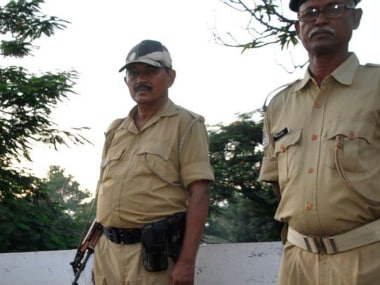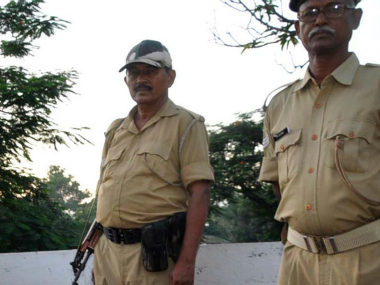Ranchi: Many residents of Jharkhand’s Jamari have never left the village but this does not stop them from sending their children away to work in big cities. A promise of a few thousand rupees is all it takes for the traffickers to lure children from the village in Godda’s Sundar Pahadi area and its neighbouring areas. [caption id=“attachment_4852371” align=“alignleft” width=“380”]  File image of Jharkhand Police. Reuters[/caption] Electricity has still not reached Jamari. They have no concept of hand pumps. The nearest school is around 1.5 kilometers away. Agriculture and cattle rearing is the most common source of income and very few villagers work as daily wage labourers. Alcoholism and lack of education remains a big problem. Most villagers seem to be unaware of the various government schemes. Mansukh (name changed), is one of the many villagers of Godda district who lost their children to human traffickers. He keeps a card of a placement agency in his pocket at all times. The card belongs to Rohit Muni, one of the state’s most wanted human traffickers. “This man took away my daughter. He said he’d send us money for the work that my daughter does. However, since my daughter left, neither did I get the money nor did I see her again,” Mansukh said. After Khunti, Gumla and Simdega, Godda district has recently emerged as a hub for human traffickers. The issue came to light after the rescue of a 15-year-old girl of Godda District from Faridabad, who was trafficked by a placement agent Surinder Malto around two years ago. Surinder raped the survivor before employing her at a household in Delhi. In January, the survivor was taken to Faridabad to another agent, Mani Mishra, who took away all the money she earned while employed at the household in Delhi and brutally beat her up. When rescued on 30 January, the young girl belonging to Paharia tribe — a particularly vulnerable tribal group (PVTG) — had to be admitted to hospital as she was suffering from tuberculosis, along with multiple injuries. Since her rescue, around a dozen more girls from the district were saved over the last few months, of which at least half have been taken back home. Haryana police arrested Surinder Malto in February. Malto not only confessed to raping the 15-year-old survivor, but also confessed to trafficking around 30 more girls from Godda district. Haryana police revealed that Surinder used “sold” these girls from Jharkhand to placement agent Mani Mishra for between Rs 15,000 and 20,000. Following Surinder’s arrest, over a half dozen girls of Paharia tribe were rescued from Faridabad and Ambala in joint operations by Godda Police and Haryana Police. Surinder also confessed to being in contact with wanted traffickers Rohit Muni and Prabha Muni. He also admitted to meeting Pannnalal Mahato, who was arrested by Khunti Police for trafficking thousands of girls from the area, and is out on bail. Godda superintendent of police Rajiv Ranjan Singh said, “Three police station areas having high tribal population, including Rajabhitta, Sundar Pahari and Dwarijor, are the most affected from human trafficking.” A team from Shakti Vahini, a social organisation working against human trafficking, recently visited Rajabhitta and Sundar Pahari, only to discover a number of adolescent girls missing from the villages. Rishi Kant of Shakti Vahini said, “Our team found that there were very few adolescent girls in these areas. Many families said their daughters were taken away by placement agents who promised them good money in return for domestic work done but the girls never returned.” Earlier, thousands of girls from Khunti, Gumla and Simdega districts were trafficked by agents. However, lately, traffickers have shifted base after police started a crackdown. Kant said, “In the last few years, the district police of Khunti, Simdega and Gumla not only rescued girls but also arresting dozens of traffickers including kingpins like Pannalal Mahato.” He added, “As a result, the traffickers started searching for new places and zeroed in on interior regions of Godda where they were able to find a number of vulnerable PVTG families who live in isolation and poverty, away from government facilities and schemes.” Considering the seriousness of the matter, the district administration launched a door to door survey in the villages to identify families where children are missing. District child protection officer (DCPO) Ritesh Kumar said, “The anganwadi sevikas have been directed to visit every household in the areas they are working and conduct a survey on missing children. Once the survey is completed, we will submit a report to the district administration for further action.” Meanwhile, Godda superintendent of police Rajiv Ranjan Singh is working on strategies to curb human trafficking from the area. Singh was earlier posted in Simdega District where he’d worked extensively against human trafficking there. “A database of traffickers is being created and a list of missing children is being prepared so that our team can work on arrests and rescues. Apart from this, awareness campaigns are being conducted by the police officers of the three concerned areas,” Singh said. However, the most effective and unique idea to curb human trafficking has come up in the form of police mitra. Singh came up with this concept to link the youth of the affected areas with ongoing projects of the district administration. “In a pilot project, we identified 100 young boys and girls of Sundar Pahari area and linked them with the ongoing Swachh Bharat Mission. These youth have been divided in groups of 10 and are currently working towards toilet construction in the area,” Singh added. Poverty and a lack of jobs are major problems. The project aims to link the youth with government programmes so that they are able to earn a decent amount of money while staying in the village. Singh said, “After completing the work under Swachh Bharat Mission, the youth will be linked to construction work in other government schemes like Indira Awas and Pradhan Mantri Awas Yojna. If the project is successful, we will implement it in other police station areas of the district as well.” He added, “We are in constant consultation with the district administration so that in the coming days more people can be linked with the government schemes.” The police mitras are also being informed about the organised crime of human trafficking and would function as whistle-blowers. “If they come across cases where youngsters are being lured away they will inform the police station about it. This way we will not just be able to save the vulnerable children but will also be able to identify the local agents who lure them away,” Singh added. The author is a member of The NewsCart, a Bengaluru-based media startup
Many residents of Jharkhand’s Jamari have never left the village but this does not stop them from sending their children away to work in big cities
Advertisement
End of Article


)

)
)
)
)
)
)
)
)



